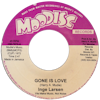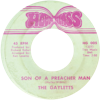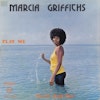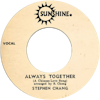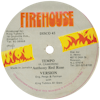Producer and label owner Harry Mudie is one of the more elusive and independent characters in the often incestuous musical fraternity of Jamaica. He created the foundation “Drifter” and “Let Me Tell You Boy” riddims in the ’60s; was the first reggae producer to employ lush string arrangements and the first to record I-Roy; he made a series of out-there, jazzy dub LPs with King Tubby; and he released a number of obscure Jamaican funk singles and continued releasing dancehall tunes into the 1990s. He is still alive and running a record shop in Florida where he, and he alone, distributes his reissued titles. As far as I know, he never licensed his work for compilations and held tight to all of his copyrights. In 1972, he also became the only record man to record a German schlager singer over a riddim that became a prototype for horn-driven minor-key roots.
In 1972, Mudie released “Love Is Gone” with John Holt. While Holt’s vocals nail the plaintive agony of love gone wrong, it is the riddim itself that shines. Set in a minor key, the riddim is led by a pulsing horn arrangement counterbalanced by Gladdy Anderson’s haunting keyboard work. It burns with dread energy, demanding a massive dub, low ceilings, smoke-filled air, and stomach-churning scoops. Hearing it for the first time, I wanted every tune on the riddim. I hunted, dug deep, and uncovered DJ versions, the Heptones’ “Love Without Feeling,” and even the phased-out dub of my dreams on a Prince Heron 12-inch. In the hills of St. Ann’s, I bought a barely playable acetate for $200 from a breadfruit farmer because it contained an unreleased dub of the track.
Even though I had dug deep into the riddim, I was unprepared the first time I heard Inge Larsen’s cover of “Love Is Gone,” retitled “Gone Is Love.” Larsen was a German folk singer who had released a few European singles during the 1960s. In 1972, she came to Jamaica for vacation and, the way I heard it, met I-Roy and was brought to Harry Mudie’s studio where Mudie, enamored at first sight, rushed her into the recording booth. I knew none of this history the first time I heard the track. What I heard against the backdrop of that deeply dread riddim was an icy, slightly monotone vocal not unlike Nico taking leave of the Velvets to drop a Jamaican tune. Despite the oddness of this concept, Larsen, with heady restraint, takes ownership of the tune. She finds subtle ways to play off the odd chord changes and charging horns. In doing so, she creates a brilliant and disorienting tension between her very European vocal and a riddim that pulsed with a certain type of deep Jamaican melancholy. “Gone Is Love” could have been a throwaway—a vacation novelty like the Word’s “Two White Girls on a Mini Bus”—but instead it became a 45 that never leaves my bag and can be played alongside some of the deepest tracks of the 1970s.
